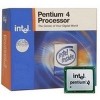Intel BX80532PG3200D Data Sheet - Page 8
Terminology, address, Intel® 64 and IA-32, Architectures Software Developer's Manuals - memory
 |
View all Intel BX80532PG3200D manuals
Add to My Manuals
Save this manual to your list of manuals |
Page 8 highlights
1.1 Introduction Terminology Term # Front Side Bus (FSB) AGTL+ Storage Conditions Processor Core Execute Disable Bit Intel® 64 Technology Definition A "#" symbol after a signal name refers to an active low signal, indicating a signal is in the active state when driven to a low level. For example, when RESET# is low, a reset has been requested. Conversely, when NMI is high, a nonmaskable interrupt has occurred. In the case of signals where the name does not imply an active state but describes part of a binary sequence (such as address or data), the "#" symbol implies that the signal is inverted. For example, D[3:0] = "HLHL" refers to a hex "A", and D[3:0]# = "LHLH" also refers to a hex "A" (H= High logic level, L= Low logic level). Refers to the interface between the processor and system core logic (also known as the chipset components). Advanced Gunning Transceiver Logic. Used to refer to Assisted GTL+ signaling technology on some Intel processors. Refers to a non-operational state. The processor may be installed in a platform, in a tray, or loose. Processors may be sealed in packaging or exposed to free air. Under these conditions, processor landings should not be connected to any supply voltages, have any I/Os biased or receive any clocks. Upon exposure to "free air" (i.e., unsealed packaging or a device removed from packaging material) the processor must be handled in accordance with moisture sensitivity labeling (MSL) as indicated on the packaging material. Processor core die with integrated L1 and L2 cache. All AC timing and signal integrity specifications are at the pads of the processor core. The Execute Disable bit allows memory to be marked as executable or nonexecutable, when combined with a supporting operating system. If code attempts to run in non-executable memory the processor raises an error to the operating system. This feature can prevent some classes of viruses or worms that exploit buffer overrun vulnerabilities and can thus help improve the overall security of the system. See the Intel® 64 and IA-32 Architectures Software Developer's Manuals for more detailed information. 64-bit memory extensions to the IA-32 architecture. Half ratio support (N/2) for Core to Bus ratio TDP VCC VSS Intel Core 2 Duo processors and Intel Core 2 Extreme processors support the N/2 feature that allows having fractional core-to-bus ratios. This feature provides the flexibility of having more frequency options and being able to have products with smaller frequency steps. Thermal Design Power. The processor core power supply. The processor ground. 8 Datasheet















